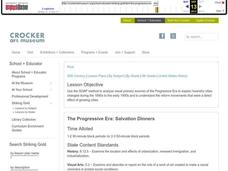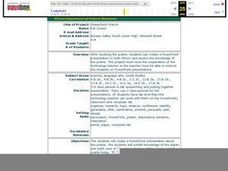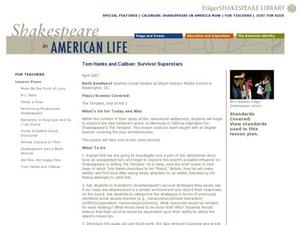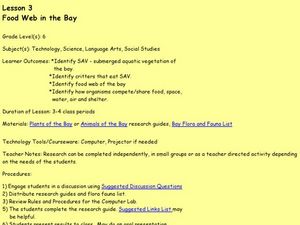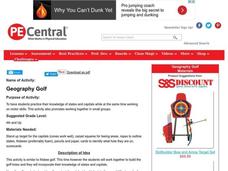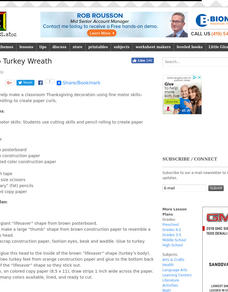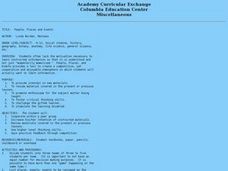Curated OER
Understanding "The Stans"
Students explore and locate "The Stans" in Central Asia to create, write and illustrate maps, graphs and charts to organize geographic information. They analyze the historical and physical characteristics of Central Asia via graphic...
Curated OER
The Progressive Era
Eighth graders utilize the SOAP method to analyze a work of art and relate it to what they know about the Progressive Era and the reasons why cities changed and the ways in which cities changed during the end of the 19th century. They...
Developing a Global Perspective for Educators
Imagine Being Me
The design of this two-day activity eloquently exposes learners to the topic of social justice for people with disabilities. The plan is built off the reading of Are You Alone on Purpose? by Nancy Werlin. The activity introduces readers...
Curated OER
Wildflower Beautification Project
Students, in cooperative groups, design and create a wildflower garden for the community. They write letters to property owners requesting use of their land and then write invitations to their parents and to local, state, and federal...
Curated OER
PowerPoint Prairie
students create a PowerPoint presentation to both inform and assess the knowledge of the prairie. This project must have the cooperation of the technology teacher or the teacher must be able to instruct Students on PowerPoint presentations.
Curated OER
Sharing is Caring
By engaging in an arts-based activity, 2nd graders explore peace in the classroom. They listen to the story The Rainbow Fish, then create their own fish to hang in the classroom. They write three things that make them happy on their...
Shakespeare in American Life
Tom Hanks and Caliban: Survivor Superstars
Here’s a clever way to combine language arts and social studies. Shakespeare’s The Tempest is believed to have been inspired by the wreck of the Sea Venture on Bermuda in 1609. The class views a brief scene from Castaway in which Tom...
Curated OER
Creating a North Carolina Gallery
Eighth graders, in teams, create a new North Carolina Gallery at the North Carolina Museum of Art. They explore the concept of citizenship by creating criteria for an artist's inclusion in the gallery.
Curated OER
Food Web in the Bay
Sixth graders study the food web in a bay. In this food web lesson, 6th graders investigate the SAV- submerged aquatic vegetation of a bay including their predators, and how the organisms eat, have proper living space and water. They...
Curated OER
Using Bar Graphs to Understand Voting Patterns
Bar graphs are used as a way to study voting patterns in the United States. A variety of statistical data is presented in the graphs, and pupils must interpret the data in order to make a report to the class. Three excellent graphs,...
Curated OER
Tobacco in North Carolina
Fourth graders examine the depiction of North Carolina tobacco farms in several photographs. They work in small groups to prepare an argument for a class debate and create promotional signs to advertise their point of view about tobacco...
Curated OER
Understanding Growth of the Phoenix Area
Students study the growth of the Phoenix area using geographic images, maps, tables, and graphs. They study the idea of community.
Rainforest Alliance
Investments in Forest Carbon
One hundred metric tons of CO2 can accumulate in one acre of forest over time—that's a lot of carbon! In the activity, groups of middle school learners determine what makes forests important. They then solidify the concept by using a...
Michigan State University
Researching and Compiling Survey Information
Bring Internet research and social issues to your language arts class in this activity. After investigating the topic "Media Violence and How It Affects Teenagers" on the Internet, middle schoolers work in groups to compile their...
Curated OER
The Vernors Lesson
Students fill out "Effects of the Civil War" question and answer sheet and discover that Vernors was created as a direct result of the Civil War.
Curated OER
What is an Animal Group?
Students discover that people live in groups and animals live in groups or alone. They list ways that families cooperate and work together as a group. They create a large dinosaur made out of geometric shapes.
Curated OER
Geography Golf
Young scholars practice their knowledge of states and capitals while at the same time working on motor skills. This activity also promotes working together in small groups.
Curated OER
Group Turkey Wreath
Students practice the fine motor skills of cutting and rolling as they make a whole class Thanksgiving wreath. They cut strips of paper and roll them on a pencil to make curls to add to a turkey wreath.
Curated OER
Latitude and Longitude
Fifth graders study latitude and longitude. They estimate the latitude and longitude of their hometown and find the latitude and longitude of other cities using a map. They use a website to find out the cities' actual latitude and...
Curated OER
Latitude & Longitude Bingo
Pupils practice map reading skills through a reinforcement game of bingo. They select any 24 of 30 listed cities to write on blank bingo cards. Then using atlases, locate a city based on the latitude and longitudinal coordinates called...
Curated OER
People, Places and Events
Students cooperate within a small group, review materials covered in previous lessons, use higher level thinking skills and gain positive feedback through competition.
Curated OER
Tales From the Crypt
Eighth graders study the people of their community. In this Geography lesson, 8th graders research local history using maps and books. Students create a timeline of tombstones for deceased residents.
Curated OER
Native Americans of the USA
Students, in cooperative groups, research a variety of Native American tribes on the Internet and complete corresponding activities. They participate in a play about Native Americans by Sandra Widener.
Curated OER
Hemispheres & Continents
Students learn in cooperative learning groups to determine how the equator and the Prime Meridian divide the earth into hemispheres and use Venn diagrams. Students will locate and label the hemispheres, continents, and oceans.



